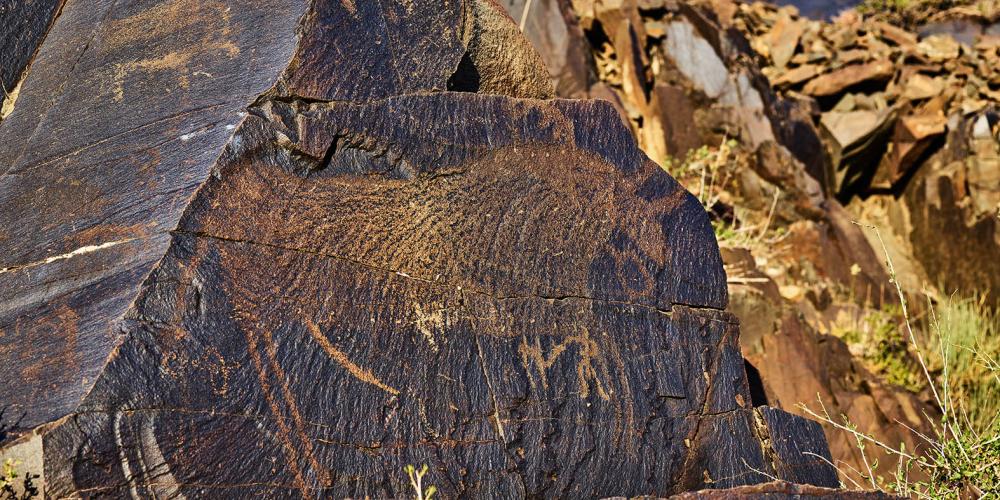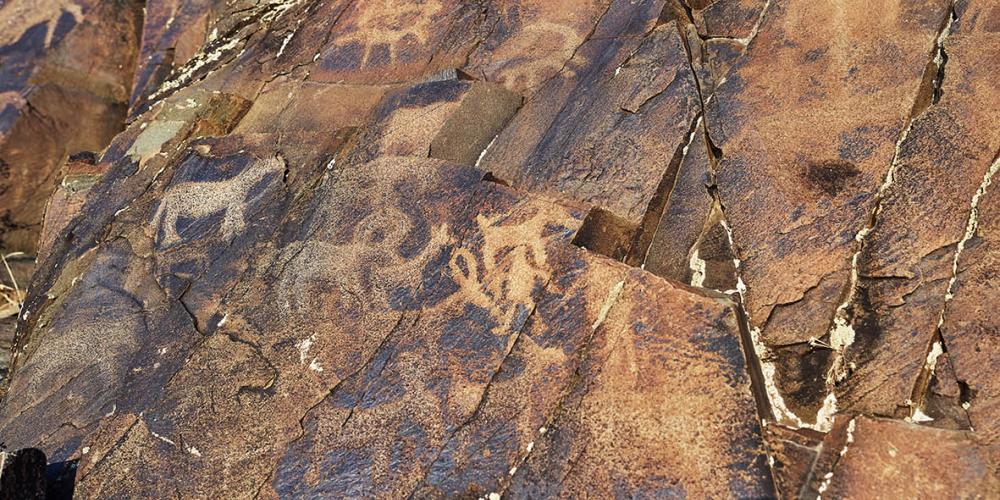Petroglyphs within the Archaeological Landscape of Tanbaly

The impressive collection of rock carvings creates the sense of an outdoor art gallery at Tanbaly (also known as Tamgaly), but these thousands of petroglyphs are more than just creative expression. They are the stories of ancient cultures who, for thousands of years, have used the gorge for shelter and the relatively fertile land for nourishment and agriculture.
The high quality artwork found in different groups around the site depicts the way life has changed over the millennia in the arid Kazakh landscapes, including traditional forms of economy, land use and social organisation, as well as spiritual beliefs. This history etched onto the rocks is especially significant because Tanbaly is positioned at the crossroads of Central Asian ancient communications. It meant that many civilisations and nomadic tribes passed through and left their mark. Not only did people express their values through the carvings, they often changed past images to reflect the evolution of cultures and ideas.

Tanbaly was not just a mere resting spot for the people of the surrounding grassland steppes - it also served as a spiritual and cultural space. The carved images and archeological findings are unique for their association with a cult centre on the site. This began in the Bronze Age around 1500 BC and is still evident today, with a clear distinction between a sacred core and a residential area. In particular, the ceremonial area is unique for its collection of altars, sacred images of sun-heads, and enclosed cult zones. Visiting Tanbaly offers an exploration of an archeological landscape that merges the site's cultural, natural and spiritual attributes with the deeper meanings people have assigned to them throughout history.

Sacred Through History
In the arid Chu-lli mountains, Tanbaly’s abundance of vegetation, springs, and shelter served as favourable conditions for long-term habitation. At all stages of the historical development, the site has kept its structure of three distinct zones - the sacred core in the valley, a residential area in the mountain periphery, and a buffer zone in between containing no remains. That was especially significant in the early Iron Age, a time of economic development resulting in a considerable growth of the residential area. The five major petroglyphs groups are situated within the cult zone, which is completely devoid of dwellings.

Many ancient burials were found on the site. The earliest were stone enclosures with boxes and cysts but since the Iron Age, most tombs consist of mounds (kargans) of stone and earth built above tombs. In the Middle Ages, the number of settlements was reduced and a process of demystification of the sacred zone started to take place. It accelerated in the last centuries, though it is still respected by the locals who hold their festivals to revive ancient traditions.
The site was discovered by archaeologists in 1957, with Anna Georgievna Maksimova initiating extensive research efforts led by D. Rogozhinsky. In 2004, it was the first monument of rock art in Central Asia to be recognised as a World Heritage Site. Archaeological study continues as the many questions about Tanbaly’s monuments and history remain unanswered.

The drawings in the Tanbaly archeological site represent different eras: Middle Bronze Age, the Late Bronze Age, early Iron Age and Middle Age. The age that represents the least number of glyphs is the Middle Age, accounting for only about 300 carvings. During the Middle Bronze Age, engravings were deeply cut in the rocks and images usually represented solar deities, disguised people, zoomorphic beings, animals and syncretic motifs.
Within a picturesque valley marked by dramatic outcrops, a path leads you past the major groups of petroglyphs, the carved white shapes still strikingly clear against the dark rock faces. The ancient images include everyday scenes like agriculture and hunting, as well as representations of religious life in the form of gods, rituals and dancing. Signs along the walk offer further information about what's on display. With Tanbaly's important cultural and spiritual significance over the different eras, you'll also find burial grounds, ruins of stone dwellings, and circular enclosures that are believed to have been used for ceremonies and sacrificial offerings.
How to get there:
There is no public transportation going to Tanbaly, or to the villages nearby, so you'll need to reach it by car.
From Almaty, it is 2.5 hours' drive, located 160 km south-east to Tanbaly. A day trip from Almaty can be arranged through a number of tour operators and guides including the official conservation authority of the site – “Reserve Museum of Tanbay”.
Another option is renting a car and travelling independently.
How to Visit
A visit to Tanbaly typically takes 2 hours of walking around the site, making it an ideal day trip from Almaty. It is signposted, though it is recommended to hire a local guide that can elaborate on the history, meaning and significance of the different attractions. Consider extending your excursion in the area to include some of the more distant complexes and petroglyphs in the surrounding hills.
Sights and Attractions recommended by the locals
Petroglyphs within the Archaeological Landscape of Tanbaly
Tambaly is open to the public year round. The best time to visit would be the summer months (June-September), as it can get cold and snowy in winter. In springtime (March-May), you'll be rewarded with the blooming of some rare tulips and other plants and flowers.





